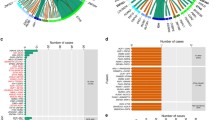Abstract
T(14;19) is an unusual but distinct genomic alteration reported in low-grade B-cell lymphomas. This structural rearrangement places BCL3 in juxtaposition with IGH inducing proliferation and has been found in chronic lymphocytic leukemia/small lymphocytic lymphoma (CLL/SLL), marginal zone lymphoma (MZL), and other low-grade B-cell lymphomas. While there are some case series describing this in the context of other cytogenetic alterations, there are limited clinical cases examined from a molecular perspective. We herein describe a case of a low-grade B-cell lymphoma with t(14;19) resulting in IGH::BCL3 fusion on which we performed whole exome sequencing to investigate genetic variants that could contribute to its pathogenesis. We found pathogenic alterations including a variant in CXCR4 which has been shown to be recurrently mutated in different low-grade B-cell lymphomas including lymphoplasmacytic lymphoma (LPL) and MZL. We describe this interesting case in the context of its genomic findings and how it contributes to the literature as a whole.




Similar content being viewed by others
References
Michaux L et al (1996) BCL3 rearrangement and t(14;19)(q32;q13) in lymphoproliferative disorders. Genes Chromosomes Cancer 15(1):38–47
Yang H et al (2022) Clinical analysis of 20 cases of small B lymphocyte proliferative disease with t (14;19) (q32;q13). Zhonghua Xue Ye Xue Za Zhi 43(8):674–679
Huh YO et al (2011) Chronic lymphocytic leukemia with t(14;19)(q32;q13) is characterized by atypical morphologic and immunophenotypic features and distinctive genetic features. Am J Clin Pathol 135(5):686–696
Schweighofer CD et al (2011) The B cell antigen receptor in atypical chronic lymphocytic leukemia with t(14;19)(q32;q13) demonstrates remarkable stereotypy. Int J Cancer 128(11):2759–2764
Huh YO et al (2007) The t(14;19)(q32;q13)-positive small B-cell leukaemia: a clinicopathologic and cytogenetic study of seven cases. Br J Haematol 136(2):220–228
Nguyen-Khac F et al (2006) The t(14;19)(q32;q13) Translocation in B lymphoproliferative disorders: a continuum from chronic lymphocytic leukemia (CLL) to marginal zone lymphoma (MZL)? Blood 108(11):4944
Carbó-Meix A et al (2021) Whole genome sequencing of B-cell neoplasms with t(14;19)(q32;q13) reveals different entities. Blood 138(Supplement 1):3709–3709
Michaux L et al (1997) t(14;19)/BCL3 rearrangements in lymphoproliferative disorders: a review of 23 cases. Cancer Genet Cytogenet 94(1):36–43
Alaggio R et al (2022) The 5th edition of the World Health Organization classification of haematolymphoid tumours: lymphoid neoplasms. Leukemia 36(7):1720–1748
Campo E et al (2022) The international consensus classification of mature lymphoid neoplasms: a report from the clinical advisory committee. Blood 140(11):1229–1253
Poulain S et al (2016) Genomic landscape of CXCR4 Mutations in Waldenström Macroglobulinemia. Clin Cancer Res 22(6):1480–1488
Cancilla D, Rettig M, DiPersio JF (2020) Targeting CXCR4 in AML and ALL. Front Oncol 10:1672
Author information
Authors and Affiliations
Contributions
Jeremiah Karrs DO: primary author, case review; Shivaprasad H. Sathyanarayana PhD: contributing author; Xinjie Xu PhD: FISH image, editing; Donald C. Green BS: bioinformatics support for sequencing; Wahab A. Kahn PhD: cytogenetic analysis; Eric Y. Loo MD: editing; Prabhjot Kaur MD: senior author, case review.
Corresponding author
Ethics declarations
Ethical approval
N/A
Informed consent
N/A
Consent for publication
N/A
Competing interests
The authors declare no competing interests.
Additional information
Publisher’s Note
Springer Nature remains neutral with regard to jurisdictional claims in published maps and institutional affiliations.
Rights and permissions
Springer Nature or its licensor (e.g. a society or other partner) holds exclusive rights to this article under a publishing agreement with the author(s) or other rightsholder(s); author self-archiving of the accepted manuscript version of this article is solely governed by the terms of such publishing agreement and applicable law.
About this article
Cite this article
Karrs, J.X., Sathyanarayana, S.H., Xu, X. et al. Indolent B-cell lymphoma with t(14;19) investigated from a molecular perspective. J Hematopathol 16, 217–221 (2023). https://doi.org/10.1007/s12308-023-00562-7
Received:
Accepted:
Published:
Issue Date:
DOI: https://doi.org/10.1007/s12308-023-00562-7




